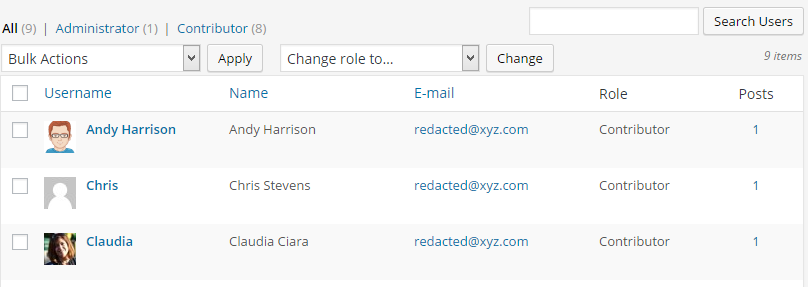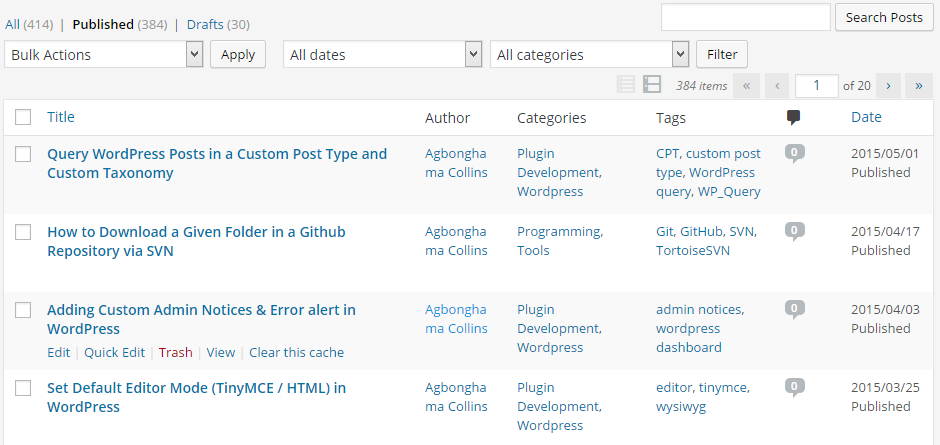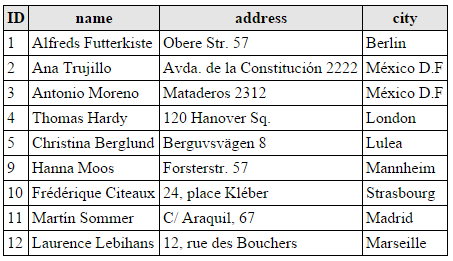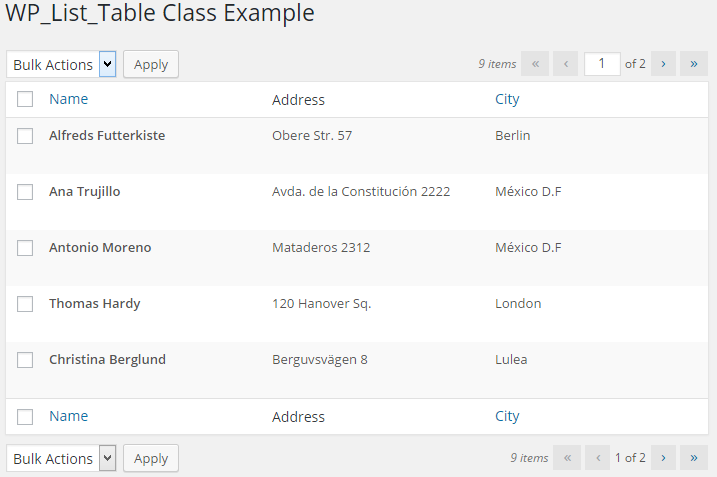In the WordPress dashboard, the tables that displays the posts, pages and user data are all created internally by WordPress using the WP_List_Table PHP class.
Below are a couple of screenshots of the post and user admin pages:

 As a plugin developer, the need to build a custom table that will contain a given data might arise. Rather than code your own table design, it’s best you use that of WordPress in order for your plugin settings page to conform to WordPress UI.
While you might be tempted to copy the HTML and CSS table design by viewing the source code of WordPress, you shouldn’t because the
As a plugin developer, the need to build a custom table that will contain a given data might arise. Rather than code your own table design, it’s best you use that of WordPress in order for your plugin settings page to conform to WordPress UI.
While you might be tempted to copy the HTML and CSS table design by viewing the source code of WordPress, you shouldn’t because the WP_List_Table class is there to help.
My acquaintance with WP_List_Table stemmed from my experience building the ProfilePress plugin. I actually used it to display the list of created user account forms in table form.
 You’ve probably used plugins that use WP_List_Table, for example, the popular Contact Form 7 plugin uses the class to display the list of created contact forms.
You’ve probably used plugins that use WP_List_Table, for example, the popular Contact Form 7 plugin uses the class to display the list of created contact forms.
Getting Familiar with WP_List_Table
We’ll build a plugin to demonstrate how to display the dummy customer database below in a table format usingWP_List_Table class.
 The plugin is comprised of two classes: a child class of
The plugin is comprised of two classes: a child class of WP_List_Table and the plugin settings class.
Extending WP_List_Table
To build a WordPress UI table, theWP_List_Table will have to be extended with a couple of its methods overridden by a child class.
Firstly, we include the class in the plugin.
if ( ! class_exists( 'WP_List_Table' ) ) {
require_once( ABSPATH . 'wp-admin/includes/class-wp-list-table.php' );
}WP_List_Table. The child class will be called Customers_List since we are dealing with a database of customers.
class Customers_List extends WP_List_Table {
/** Class constructor */
public function __construct() {
parent::__construct( [
'singular' => __( 'Customer', 'sp' ), //singular name of the listed records
'plural' => __( 'Customers', 'sp' ), //plural name of the listed records
'ajax' => false //should this table support ajax?
] );
}get_customers() method below query the customer database and return the data in array format.
/**
* Retrieve customer’s data from the database
*
* @param int $per_page
* @param int $page_number
*
* @return mixed
*/
public static function get_customers( $per_page = 5, $page_number = 1 ) {
global $wpdb;
$sql = "SELECT * FROM {$wpdb->prefix}customers";
if ( ! empty( $_REQUEST['orderby'] ) ) {
$sql .= ' ORDER BY ' . esc_sql( $_REQUEST['orderby'] );
$sql .= ! empty( $_REQUEST['order'] ) ? ' ' . esc_sql( $_REQUEST['order'] ) : ' ASC';
}
$sql .= " LIMIT $per_page";
$sql .= ' OFFSET ' . ( $page_number - 1 ) * $per_page;
$result = $wpdb->get_results( $sql, 'ARRAY_A' );
return $result;
}$per_page and $page_number arguments defines the SQL limit and the current page number.
To learn more about paginating data set, See these tutorials.
The delete_customer() method takes care of deleting a given record from the database.
/**
* Delete a customer record.
*
* @param int $id customer ID
*/
public static function delete_customer( $id ) {
global $wpdb;
$wpdb->delete(
"{$wpdb->prefix}customers",
[ 'ID' => $id ],
[ '%d' ]
);
}record_count() simply returns the number of customers in the database.
/**
* Returns the count of records in the database.
*
* @return null|string
*/
public static function record_count() {
global $wpdb;
$sql = "SELECT COUNT(*) FROM {$wpdb->prefix}customers";
return $wpdb->get_var( $sql );
}WP_List_Table has a no_items() method that returns No items found when no data is found.
To include a custom message, we have to create the same method in our child class but with a different return message.
/** Text displayed when no customer data is available */
public function no_items() {
_e( 'No customers avaliable.', 'sp' );
}column_name method renders the name column of the table. A delete link is added below the customer name by passing an array containing the link key and value to row_action method.
/**
* Method for name column
*
* @param array $item an array of DB data
*
* @return string
*/
function column_name( $item ) {
// create a nonce
$delete_nonce = wp_create_nonce( 'sp_delete_customer' );
$title = '<strong>' . $item['name'] . '</strong>';
$actions = [
'delete' => sprintf( '<a href="?page=%s&action=%s&customer=%s&_wpnonce=%s">Delete</a>', esc_attr( $_REQUEST['page'] ), 'delete', absint( $item['ID'] ), $delete_nonce )
];
return $title . $this->row_actions( $actions );
}column_default method whose function is to render a column when no specific method exists for that column will handle their output.
/**
* Render a column when no column specific method exists.
*
* @param array $item
* @param string $column_name
*
* @return mixed
*/
public function column_default( $item, $column_name ) {
switch ( $column_name ) {
case 'address':
case 'city':
return $item[ $column_name ];
default:
return print_r( $item, true ); //Show the whole array for troubleshooting purposes
}
}column_cb method is used to render the checkbox responsible for carrying out bulk data operations.
/**
* Render the bulk edit checkbox
*
* @param array $item
*
* @return string
*/
function column_cb( $item ) {
return sprintf(
'<input type="checkbox" name="bulk-delete[]" value="%s" />', $item['ID']
);
}get_columns() returns an array of columns that are going to be used in your table.
/**
* Associative array of columns
*
* @return array
*/
function get_columns() {
$columns = [
'cb' => '<input type="checkbox" />',
'name' => __( 'Name', 'sp' ),
'address' => __( 'Address', 'sp' ),
'city' => __( 'City', 'sp' )
];
return $columns;
}get_sortable_columns() method defines the columns to make sortable. Thus, WordPress will add a link to the title of the column which when clicked, changes the order of data presentation.
/**
* Columns to make sortable.
*
* @return array
*/
public function get_sortable_columns() {
$sortable_columns = array(
'name' => array( 'name', true ),
'city' => array( 'city', false )
);
return $sortable_columns;
}get_bulk_actions() should return an associative array containing all the bulk actions available for the table.
/**
* Returns an associative array containing the bulk action
*
* @return array
*/
public function get_bulk_actions() {
$actions = [
'bulk-delete' => 'Delete'
];
return $actions;
}prepare_items method is where the data query and filter, sort handling, pagination, and any other data-manipulation required prior to rendering is carried out.
Note: the method must include a call to the items parent class properties and the store the array of database data saved against it.
/**
* Handles data query and filter, sorting, and pagination.
*/
public function prepare_items() {
$this->_column_headers = $this->get_column_info();
/** Process bulk action */
$this->process_bulk_action();
$per_page = $this->get_items_per_page( 'customers_per_page', 5 );
$current_page = $this->get_pagenum();
$total_items = self::record_count();
$this->set_pagination_args( [
'total_items' => $total_items, //WE have to calculate the total number of items
'per_page' => $per_page //WE have to determine how many items to show on a page
] );
$this->items = self::get_customers( $per_page, $current_page );
}process_bulk_action()? This method takes care of the deleting customers record either when the delete link is clicked or when a group of records is checked and the delete option is selected from the bulk action.
public function process_bulk_action() {
//Detect when a bulk action is being triggered...
if ( 'delete' === $this->current_action() ) {
// In our file that handles the request, verify the nonce.
$nonce = esc_attr( $_REQUEST['_wpnonce'] );
if ( ! wp_verify_nonce( $nonce, 'sp_delete_customer' ) ) {
die( 'Go get a life script kiddies' );
}
else {
self::delete_customer( absint( $_GET['customer'] ) );
wp_redirect( esc_url( add_query_arg() ) );
exit;
}
}
// If the delete bulk action is triggered
if ( ( isset( $_POST['action'] ) && $_POST['action'] == 'bulk-delete' )
|| ( isset( $_POST['action2'] ) && $_POST['action2'] == 'bulk-delete' )
) {
$delete_ids = esc_sql( $_POST['bulk-delete'] );
// loop over the array of record IDs and delete them
foreach ( $delete_ids as $id ) {
self::delete_customer( $id );
}
wp_redirect( esc_url( add_query_arg() ) );
exit;
}
}Building the Settings Page
We create the class for the settings page populated with the constructor method and properties.class SP_Plugin {
// class instance
static $instance;
// customer WP_List_Table object
public $customers_obj;
// class constructor
public function __construct() {
add_filter( 'set-screen-option', [ __CLASS__, 'set_screen' ], 10, 3 );
add_action( 'admin_menu', [ $this, 'plugin_menu' ] );
}set-screen-option filter and admin_menu action hook.
public static function set_screen( $status, $option, $value ) {
return $value;
}
public function plugin_menu() {
$hook = add_menu_page(
'Sitepoint WP_List_Table Example',
'SP WP_List_Table',
'manage_options',
'wp_list_table_class',
[ $this, 'plugin_settings_page' ]
);
add_action( "load-$hook", [ $this, 'screen_option' ] );
}plugin_menu() methods that creates the settings page includes a callback screen_option() method to create the screen option for setting the default number of data to display in the table.

/**
* Screen options
*/
public function screen_option() {
$option = 'per_page';
$args = [
'label' => 'Customers',
'default' => 5,
'option' => 'customers_per_page'
];
add_screen_option( $option, $args );
$this->customers_obj = new Customers_List();
}Customers_List child class and saved the object to the customers_obj property defined earlier at the class declaration.
Below is the plugin_settings_page callback method that displays the content of the settings page.
/**
* Plugin settings page
*/
public function plugin_settings_page() {
?>
<div class="wrap">
<h2>WP_List_Table Class Example</h2>
<div id="poststuff">
<div id="post-body" class="metabox-holder columns-2">
<div id="post-body-content">
<div class="meta-box-sortables ui-sortable">
<form method="post">
<?php
$this->customers_obj->prepare_items();
$this->customers_obj->display(); ?>
</form>
</div>
</div>
</div>
<br class="clear">
</div>
</div>
<?php
}prepare_items() to prepare the data and then display() to display the table content.
To ensure only one object instance exists, here’s the singleton method.
/** Singleton instance */
public static function get_instance() {
if ( ! isset( self::$instance ) ) {
self::$instance = new self();
}
return self::$instance;
}add_action( 'plugins_loaded', function () {
SP_Plugin::get_instance();
} );
Summary
In this tutorial, we’ve covered how to display custom data retrieved from the database in tabular format using the powerfulWP_List_Table PHP Class.
The plugin source code is available on GitHub. Download, install it in your WordPress powered site and explore the code.
If you have any questions or contributions, let us know in the comments.
Frequently Asked Questions (FAQs) about Using WP_List_Table to Create WordPress Admin Tables
What is WP_List_Table and why is it important in WordPress?
WP_List_Table is a core class in WordPress that provides a standardized structure for displaying data in a table format in the WordPress admin area. It is important because it allows developers to create consistent, user-friendly tables for managing data. This class provides a set of methods and properties that can be overridden to customize the table’s appearance and behavior, making it a flexible tool for displaying any type of data in the WordPress admin.
How can I extend the WP_List_Table class?
To extend the WP_List_Table class, you need to create a new class that inherits from it. This new class can override the methods and properties of the WP_List_Table class to customize the table’s functionality. For example, you can override the column_default() method to define how data for each column should be displayed.
How can I add custom columns to a WP_List_Table?
Adding custom columns to a WP_List_Table involves overriding the get_columns() method in your extended class. This method should return an associative array where the keys are the column slugs and the values are the display names for the columns. You can then define how data for these columns should be displayed by overriding the column_default() method.
How can I make a WP_List_Table sortable?
To make a WP_List_Table sortable, you need to override the get_sortable_columns() method in your extended class. This method should return an array where the keys are the column slugs and the values are the corresponding database column names. WordPress will then automatically handle sorting the table when the user clicks on the column headers.
How can I add bulk actions to a WP_List_Table?
Adding bulk actions to a WP_List_Table involves overriding the get_bulk_actions() method in your extended class. This method should return an array where the keys are the action slugs and the values are the display names for the actions. You can then handle these actions by checking the ‘action’ parameter in the $_REQUEST global variable.
How can I add filters to a WP_List_Table?
Adding filters to a WP_List_Table involves adding a form with select elements above the table. The options for these select elements can be populated based on the data in the table. When the form is submitted, you can filter the table data based on the selected options by modifying the query used to retrieve the data.
How can I paginate a WP_List_Table?
Paginating a WP_List_Table involves setting the ‘per_page’ property in your extended class and calling the set_pagination_args() method in the prepare_items() method. The ‘per_page’ property determines how many items should be displayed per page, and the set_pagination_args() method sets up the pagination based on the total number of items and the ‘per_page’ property.
How can I add a search box to a WP_List_Table?
Adding a search box to a WP_List_Table involves calling the search_box() method in your extended class. This method takes two parameters: the text for the search button and the ‘input_id’ for the search input. You can then handle the search query by checking the ‘s’ parameter in the $_REQUEST global variable.
How can I customize the display of a WP_List_Table?
Customizing the display of a WP_List_Table involves overriding the various methods in your extended class that control the table’s appearance. For example, you can override the column_default() method to customize how data for each column is displayed, or the extra_tablenav() method to add custom navigation elements above or below the table.
How can I handle errors when using WP_List_Table?
Handling errors when using WP_List_Table typically involves checking the return values of the various methods that interact with the database. If these methods return a WP_Error object, you can display the error message to the user using the admin_notices action hook.
Collins is a web developer and freelance writer. Creator of the popular ProfilePress and MailOptin WordPress plugins. When not wrangling with code, you can find him writing at his personal blog or on Twitter.

